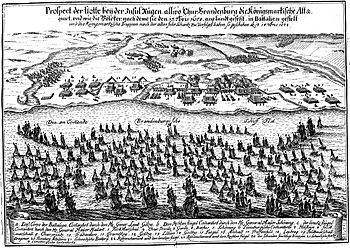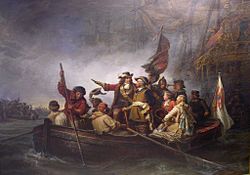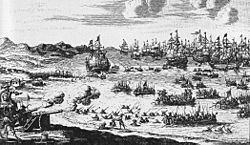Invasion of Rügen (1678) facts for kids
Quick facts for kids Invasion of Rügen |
|||||||
|---|---|---|---|---|---|---|---|
 The invasion fleet and the army in order of battle on 23 September 1678 near Neukamp |
|||||||
|
|||||||
| Belligerents | |||||||
| Commanders and leaders | |||||||
|
Commander-in-Chief:
|
Commander-in-Chief:
Landing Corps
Battle fleet:
Transport fleet:
|
||||||
| Strength | |||||||
|
2,700 men
|
ca. 9,000 men
|
||||||
The invasion of Rügen was a big military operation that happened between September 22 and 24, 1678. It was part of the Swedish-Brandenburg War and the Scanian War. During this event, the island of Rügen, which was controlled by Sweden, was taken over by the Allies: Brandenburg-Prussia and Denmark. The Allies held the island for almost a year before it was given back to Sweden in a peace agreement. This invasion was also an important step before the Siege of Stralsund, which happened soon after.
Contents
Why Rügen Was Important
The island of Rügen was very important for both sides fighting in the war. The first time Rügen was invaded in this war was on September 17, 1677. Back then, the Danes landed on the island and, after a battle, pushed the Swedes out.
However, the Swedes, led by Field Marshal Otto Wilhelm von Konigsmark, quickly tried to get the island back. They succeeded on January 18, 1678, in a battle called the Battle of Warksow. Even after this Swedish win, the island wasn't safe. The Danes kept making small attacks on Rügen throughout the summer.
Controlling Rügen was key because it helped supply the most important Swedish fortress in Swedish Pomerania, which was the town of Stralsund. Stralsund was on the mainland coast, right next to Rügen. So, if the Allies (Brandenburg and Denmark) wanted to capture Stralsund, they first needed to control Rügen.
The Invasion Begins
For the invasion, Denmark provided 27 warships to protect the landing troops. Brandenburg also had 10 warships. Seven of these were rented from a person named Benjamin Raule, and three were provided by the prince-elector himself.
A Brandenburg army had been waiting in Pomerania since mid-July 1678. The invasion was delayed because the Brandenburg warships arrived late in August. Also, Brandenburg needed a lot of time to gather enough transport ships. They ended up with 210 large ships and 140 smaller ones.
The Danish Admiral Nils Juel was in charge of the navy. Admiral Cornelis Tromp commanded the transport fleet. The Brandenburg troops, who would land on the island, were led by General Field Marshal Derfflinger. The Brandenburg landing force had about 7,240 soldiers, including cavalry and infantry. They also brought some cannons. The Danish landing force had 1,800 soldiers.
The entire fleet gathered in the Bay of Greifswald. The plan was for the Danes to land in the north of Rügen and the Brandenburg troops to land in the south. This would split up the smaller Swedish forces on the island.
Landing on Rügen
The Brandenburg navy, led by the Elector Frederick William, set sail on September 22. To keep the Swedes guessing about where they would land, the fleet planned to sail past Palmer Ort and then turn towards Putbus.
However, when they reached Palmer Ort, the wind changed direction. This made their planned turn impossible. On top of that, the Swedes had cannons on Zudar, the southernmost part of Rügen, and they started firing at the invasion fleet. A cannonball even landed close to the Elector! The fleet had trouble sailing away from the Swedish cannons and had to drop anchor, waiting for better winds.
Despite the wind issues, the Danes, led by Admiral Nils Juel, successfully landed on September 22. They landed at Cape Arkona, near a fishing village called Vittorio. A small group of Swedish soldiers tried to stop them but were pushed back. The Danes lost 57 soldiers and had 52 wounded in this small fight. The Swedes lost more. After landing, the Danes built defenses on a narrow strip of land called the Schaabe. When the Swedish field marshal, Königsmarck, heard about the Danish landing, he ordered his troops to retreat to Altefähr.
The Elector, impatient because the Danes had already landed, ordered his troops to land at the closest possible spot. He worried that the Swedes would focus all their attacks on the Danes. So, on September 23, 1678, the Brandenburg forces landed near Neukamp. There, they faced a small Swedish fort with eight cannons and some cavalry. The Brandenburg troops attacked but couldn't take it at first. When more Brandenburg troops arrived with their own cannons, the Swedes pulled back.
Within two hours, all the Brandenburg landing troops were ashore. The Elector and Field Marshal Derfflinger were both there. The infantry immediately started building defenses to protect themselves from a possible Swedish attack. Königsmarck, who had rushed over from the Zudar peninsula, retreated when he saw the large Brandenburg army ready for battle.
The Brandenburg cavalry chased the Swedes, capturing 200 of them. On the morning of September 24, Derfflinger and his cavalry continued chasing the Swedes. The Swedes reached Altefähr, where they became very confused, all trying to get to Stralsund. The Brandenburg cavalry took advantage of this and stormed the defenses. They captured over 700 prisoners, 250 warhorses, and all the Swedish cannons. Königsmarck barely escaped, but many crowded boats sank as they tried to cross to Stralsund.
The Brandenburg troops also easily captured the important Neufähr Redoubt (another small fort). The soldiers defending this fort were mostly Danish and Brandenburg prisoners of war. They had been captured in January during the Battle of Warksow. These prisoners rebelled against their Swedish officers and handed the fort over to the Brandenburg troops without a fight. With this, the island of Rügen was once again controlled by the Allies.
What Happened Next
After Rügen was captured, the fate of the Swedish fortress of Stralsund was sealed. Brandenburg troops began to besiege Stralsund. While Danish troops stayed on Rügen, the Brandenburg forces returned to the mainland to help with the siege.
The Allies captured Stralsund after a heavy bombardment. Half the town caught fire and burned until October 22, 1678.
As promised, the island of Rügen was given to the Danes, who occupied it until a peace treaty was signed. However, after the Treaty of Saint-Germain on June 29, 1679, Rügen was returned to Sweden. The island itself was in very bad shape because of all the battles and the many foreign troops. The Danish soldiers occupying the island had to be supplied with food and other things from Denmark until the war ended.
Remembering the Invasion
To remember the different landings on Rügen, the Prussian king Frederick William IV ordered two tall monuments, called Prussia Columns, to be built in 1854 and 1855. These columns were 15 meters high and were placed at the landing sites. The monument at Neukamp, which shows the Great Elector Frederick William, was officially opened on October 15, 1854. These columns also showed how powerful Prussia was and its claim over the southern Baltic Sea region.
Literature
- Maren Lorenz: Das Rad der Gewalt. Militär und Zivilbevölkerung in Norddeutschland nach dem Dreißigjährigen Krieg (1650–1700), Böhlau, Cologne 2007.
- Otto Wendler: Geschichte Rügens – von der ältesten Zeit bis auf die Gegenwart, 1895.
- Curt Jany: Geschichte der Preußischen Armee. Vom 15. Jahrhundert bis 1914. Vol. 1, Biblio Verlag, Osnabrück 1967, pages 258–261.





